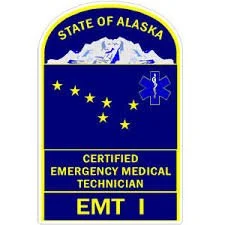Basic First Aid Training
Because when things go wrong, training is all you’ve got.
This course teaches you how to handle the moment between injury and rescue. You’ll learn CPR, AED use, bleeding control, burns, fractures, allergic reactions, and medical emergencies that don’t wait for an ambulance.
No boring lectures or soft skills. Just real instruction from people who’ve worked in the dirt, ice, and chaos. Offered in-person, online, or hybrid. Certification good for two years. Skills that stick for life.
Alaska Emergency Trauma Training
40 Hours can be done in person or Hybrid via online and in person skills assessments
Forty hours that separate those who say they can handle an emergency from those who actually can.
This program teaches the foundations of real emergency care: patient assessment, bleeding control, airway management, oxygen therapy, splinting, CPR, AED use, and medical emergency recognition. Students learn to manage heart attacks, strokes, overdoses, hypothermia, burns, and trauma when every second counts.
Born in Alaska’s logging camps and refined in the state’s toughest conditions, the ETT course builds adaptable responders ready for anywhere care. Courses can be customized for your team, your mission, and your environment.
Forty hours. Real skills. No spectators.
Emergency Medical Technician I (Bridge)
80 Hours can be done in person or Hybrid via online and in person skills assessments
Step up from responder to provider.
This 80-hour bridge transforms current Alaska ETTs into licensed EMT-1 professionals. You’ll expand your foundation with advanced patient assessment, airway management, trauma and hemorrhage control, spinal motion restriction, splinting, and medical emergency management.
Training blends pre-course study, focused hands-on sessions, and realistic scenarios that test judgment under pressure. Students complete a psychomotor portfolio, state-standard testing, and the Alaska EMT-1 cognitive exam.
Built for those ready to move from First Responder care to full Basic Life Support responsibilits in the field.
Emergency Medical Technician I
The entry point into professional emergency medicine.
This 120–160 hour program prepares you to deliver prehospital care and life-saving interventions for patients of all ages. Training combines classroom instruction, hands-on skills labs, and field experience designed for real-world readiness.
You’ll master patient assessment, airway management, CPR/AED use, oxygen and suction, hemorrhage control, trauma care, pharmacology, and EMS operations.
No filler. No fluff. Just the skills and confidence to make a difference when it matters most.
Intermediate Life Support & Advanced Life Support Courses
Course lengths vary based on the ALS level you are pursuing
For providers who refuse to stay basic.
Tacline’s ALS courses push experienced EMTs into advanced practice. Training covers advanced airway management, IV and IO access, cardiac rhythm interpretation, pharmacology, trauma care, and critical decision-making in austere environments.
Every course is built to fit your agency’s scope, state regulations, and operational demands. A pre-course consultation locks in objectives, prerequisites, assessments, and logistics.
You bring the experience. We sharpen it into capability.
Wilderness Basic & First Responder Training
Forget the tourist version of wilderness medicine. This isn’t a weekend getaway where you wrap your buddy in gauze, post a selfie, and call yourself a backcountry first aider
Our courses teaches what actually works when you’re soaked, freezing, and hours from extraction. You’ll learn scene safety, patient assessment, airway and bleeding control, shock management, and improvised care with whatever you have left in your pack.
Recreational folks get survival-grade first aid that doesn’t rely on perfect weather or cell service. Professionals get advanced techniques in prolonged field care, patient monitoring, and real-world evacuation decision making.
We don’t hand out participation patches. We build medics who can keep people alive when there’s no one else coming.
Wildland Fire Medical Training (Single Resource)
If you think wildland fire medical work is just wilderness first aid with a radio, you’re already behind. Alaska doesn’t play by the Lower 48’s rules, it rewrites them.
This course was built for medics who operate solo, far from pavement, with no resupply, no evac guarantee, and no margin for error. You’ll train in real Alaskan terrain under conditions that eat “comfortable” for breakfast. From helicopter insertions to patient packaging in permafrost muck, this program turns skilled EMTs and paramedics into adaptable single-resource operators who can stabilize, sustain, and extract under fire conditions that would break most systems.
You’ll master prolonged field care, medical decision-making in isolation, radio and aviation integration, fireline operations, and how to work seamlessly within incident command.
This course isn’t run by PowerPoint warriors or career desk jockeys. It’s led by active Alaska-based wildland fire medics and instructors with real patient experience, field credibility, and the scars to prove it.
Why Alaska?
Because no other place combines fire, terrain, weather, and distance like this. Here, the environment is the test. When you train in Alaska, you don’t just learn wildland medicine — you earn it.






